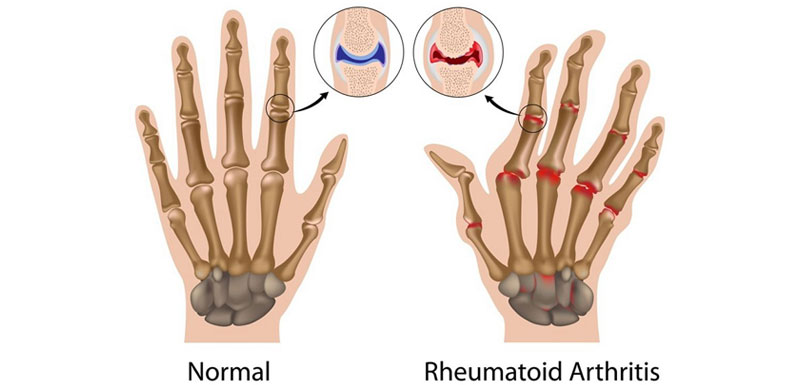Compiled by Dr. Rajesh Nashine, BAMS
How to recover from Amavata (rheumatoid arthritis):-
Amavata is a disease that initially manifests as a gut disorder with symptoms of indigestion and anorexia.
Later the disease is seen to encroach all the tissues, mainly bones, muscles, and joints, and multiple organs to cause a symptom complex. This condition is often compared to the Rheumatoid arthritis of the modern-day. Some authors have also compared it to stages of gouty arthritis. The disease is formed due to the vicious amalgamation of morbid Vata and ama.
Causes of rheumatoid arthritis :
1.) Mutually incompatible foods (Viruddha Ahara)
2.) Unwholesome lifestyle practices ( Viruddha Chesta )
3.) Having low metabolism and sluggish digestion for a longer period (Mandagni )
4.) Sedentary life activities ( Nischala )
5.) Consuming unctuous, oily, and high caloric food and immediately getting indulged in exercises (Snigdhabhojana before vyayama)
6.) Emotional factors such as passion, anger, greed, confusion, envy, grief, excitement, fear, etc.
How is Amavata formed?
Due to the above-said causes, plenty of ama is formed in the body. The vata also gets vitiated and pushes the ama into different parts of the body through circulation. Mainly Vayu pushes the ama into the shleshmasthana (sites of Kapha), mainly the bony joints and muscles. The ama on further vitiation by Vata and Kapha enters the circulation and later gets associated with morbid Pitta. This gives the combination a corrosive nature and they tend to destroy any tissue or organ with which they come into contact. The vitiated ama and Vata get lodged in various joints, mainly in the low back, pelvis, and hips and causes stiffness of the body along with severe pain.

Signs and Symptoms of Amavata :
1.) Morning pain severe in nature (Vriscikdamshavata Vedana)
2.) Shifting pain (Sanchari Vedana)
3.) Stiffness of joints (Stambha)
4.) Increase temperature (Jwara )
5.) loss of movements (Karmahani)
6.) Joint deformity (Sandhi Vikruti)
7.) Loss of appetite (Kshudhamandya)
Signs and Symptoms of Amavata according to doshas :
Vitiated Vata produces colicky pain, body ache, abdominal distension, giddiness, stiffness of back and waist, constriction, and spasm of blood vessels.
Vitiated Pitta produces fever, diarrhea, thirst, giddiness, and delirium.
Vitiated Kapha produces vomiting, anorexia, indigestion, fevers with cold, lassitude, and heaviness in the body.
Classification :
1.) Vataj – pain is severe in this type.
2.) Pittanubandhi – burning sensation and redness of the affected joints is present.
3.) Kaphanubandhi – loss of movement and itching is seen in this type.
4.) The prognosis (Sadhyasadhyata)
5.) Disease with early-onset and single dosha prominence in a young individuals can be cured with proper treatment.
6.) As the disease becomes chronic it involves multiple systems, which makes the disease incurable.
Line of Treatment :
1.) Langhana (Fasting)
2.) Shodhanachikitsa (Purification of the body)
3.) Shamanachikitsa (Treatment to reduce symptoms)
4.) Hot fomentation can be done for the affected joints.
5.) Medicines for promoting the digestive fire, amapachana, can be used. These include Amrithothoramkashayam, Rasnaerandadikashayam, Amritarishtam, Amritadichoornam, and Amavatari rasa. Again, the medicines must be given after assessing the rogi and rogabala only.
6.) Mriduvirechana (mild purgation) can be given. Ksharavasti or Vaitaranavasti can be given. This is medicated self-administered enema therapy. Upanaha can be done on affected joints.
Diet And Lifestyle Regimen :
1.) Avoid curd, fish, milk, urad dal, and jaggery
2.) Consume horse gram, ginger, bitter gourd, and drumsticks
3.) Intake of garlic is advised
4.) Avoid daytime sleep
5.) Evacuate bowels regularly
6.) Always use warm water to drink and for taking a bath
7.) Reduce stress by practicing yoga and meditation
8.) Weight should be controlled, avoid a high-fat diet
9.) Ideally, consult with a qualified Ayurvedic practitioner to get proper treatment for the management of Amavata.




1 Comment
Dillima Lingam
Hi, I find the blog informative, though… nice work… do share such information. I’ll bookmark your website.It was such a wonderful and useful article about rheumatoid arthritis. It is a must-readable blog to know the brief details of rheumatoid arthritis.This information is so helpful for me.